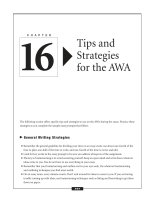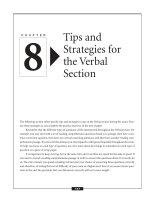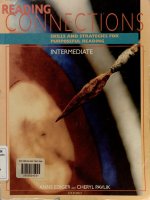Techniques and Strategies
Bạn đang xem bản rút gọn của tài liệu. Xem và tải ngay bản đầy đủ của tài liệu tại đây (99.53 KB, 10 trang )
All Tests Are Not Alike
The SAT is not like the tests you are used to taking in school. It may test the same skills and concepts that your
teachers have tested you on, but it tests them in different ways. Therefore, you need to know how to approach the
questions on the SAT so that they don’t surprise you with their tricks.
CHAPTER
Techniques and
Strategies
The next four chapters will help you review all the mathematics you
need to know for the SAT. However, before you jump ahead, make sure
you first read and understand this chapter thoroughly. It includes tech-
niques and strategies that you can apply to all SAT math questions.
4
27
The Truth about Multiple-
Choice Questions
Many students think multiple-choice questions are
easier than other types of questions because, unlike
other types of questions, they provide you with the
correct answer. You just need to figure out which of the
provided answer choices is the correct one. Seems sim-
ple, right? Not necessarily.
There are two types of multiple-choice questions.
The first is the easy one. It asks a question and provides
several answer choices. One of the answer choices is
correct and the rest are obviously wrong. Here is an
example:
Who was the fourteenth president of the United
States?
a. Walt Disney
b. Tom Cruise
c. Oprah Winfrey
d. Franklin Pierce
e. Homer Simpson
Even if you don’t know who was the fourteenth
president, you can still answer the question correctly
because the wrong answers are obviously wrong. Walt
Disney founded the Walt Disney Company, Tom Cruise
is an actor, Oprah Winfrey is a talk show host, and
Homer Simpson is a cartoon character. Answer choice
c, Franklin Pierce, is therefore correct.
Unfortunately, the SAT does not include this type
of multiple-choice question. Instead, the SAT includes
the other type of multiple-choice question. SAT ques-
tions include one or more answer choices that seem
correct but are actually incorrect. The test writers include
these seemingly correct answer choices to try to trick
you into picking the wrong answer.
Let’s look at how an SAT writer might write a
question about the fourteenth president of the United
States:
Who was the fourteenth president of the United
States?
a. George Washington
b. James Buchanan
c. Millard Fillmore
d. Franklin Pierce
e. Abraham Lincoln
This question is much more difficult than the
previous question, isn’t it? Let’s examine what makes it
more complicated.
First, all the answer choices are actual presidents.
None of the answer choices is obviously wrong. Unless
you know exactly which president was the fourteenth,
the answer choices don’t give you any hints. As a result,
you may pick George Washington or Abraham Lincoln
because they are two of the best-known presidents.
This is exactly what the test writers would want you to
do! They included George Washington and Abraham
Lincoln because they want you to see a familiar name
and assume it’s the correct answer.
But what if you know that George Washington
was the first president and Abraham Lincoln was the
sixteenth president? The question gets even trickier
because the other two incorrect answer choices are
James Buchanan, the thirteenth president, and Mil-
lard Fillmore, the fifteenth president. In other words,
unless you happen to know that Franklin Pierce was the
fourteenth president, it would be very difficult to fig-
ure out he is the correct answer based solely on the
answer choices.
In fact, incorrect answer choices are often called
distracters because they are designed to distract you
from the correct answer choice.
This is why you should not assume that multiple-
choice questions are somehow easier than other types
of questions. They can be written to try to trip you up.
But don’t worry. There is an important technique
that you can use to help make answering multiple-
choice questions easier.
–
TECHNIQUES AND STRATEGIES
–
28
Finding Four Incorrect Answer
Choices Is the Same as
Finding One Correct Answer
Choice
Think about it: A multiple-choice question on the SAT
has five answer choices. Only one answer choice is cor-
rect, which means the other four must be incorrect. You
can use this fact to your advantage. Sometimes it’s eas-
ier to figure out which answer choices are incorrect
than to figure out which answer choice is correct.
Here’s an exaggerated example:
What is 9,424 ϫ 2,962?
a. 0
b. 10
c. 20
d. 100
e. 27,913,888
Even without doing any calculations, you still
know that answer choice e is correct because answer
choices a, b, c, and d are obviously incorrect. Of course,
questions on the SAT will not be this easy, but you can
still apply this idea to every multiple-choice question on
the SAT. Let’s see how.
Get Rid of Wrong Answer
Choices and Increase
Your Luck
Remember that multiple-choice questions on the SAT
contain distracters: incorrect answer choices designed
to distract you from the correct answer choice. Your job
is to get rid of as many of those distracters as you can
when answering a question. Even if you can get rid of
only one of the five answer choices in a question, you
have still increased your chances of answering the ques-
tion correctly.
Think of it this way: Each SAT question provides
five answer choices. If you guess blindly from the five
choices, your chances of choosing the correct answer
are 1 in 5, or 20%. If you get rid of one answer choice
before guessing because you determine that it is incor-
rect, your chances of choosing the correct answer are 1
in 4, or 25%, because you are choosing from only the
four remaining answer choices. If you get rid of two
incorrect answer choices before guessing, your chances
of choosing the correct answer are 1 in 3, or 33%. Get
rid of three incorrect answer choices, and your chances
are 1 in 2, or 50%. If you get rid of all four incorrect
answer choices, your chances of guessing the correct
answer choice are 1 in 1, or 100%! As you can see, each
answer choice you eliminate increases your chances of
guessing the correct answer.
ODDS YOU CAN
NUMBER OF GUESS THE
DISTRACTERS CORRECT
YOU ELIMINATE ANSWER
0 1 in 5, or 20%
1 1 in 4, or 25%
2 1 in 3, or 33%
3 1 in 2, or 50%
4 1 in 1, or 100%
Of course, on most SAT questions, you won’t be
guessing blindly—you’ll ideally be able to use your
math skills to choose the correct answer—so your
chances of picking the correct answer choice are even
greater than those listed above after eliminating
distracters.
–
TECHNIQUES AND STRATEGIES
–
29
How to Get Rid of Incorrect
Answer Choices
Hopefully you are now convinced that getting rid of
incorrect answer choices is an important technique to
use when answering multiple-choice questions. So how
do you do it? Let’s look at an example of a question you
could see on the SAT.
The statement below is true.
All integers in set A are odd.
Which of the following statements must also
be true?
a. All even integers are in set A.
b. All odd integers are in set A.
c. Some integers in set A are even.
d. If an integer is even, it is not in set A.
e. If an integer is odd, it is not in set A.
First, decide what you are looking for: You need
to choose which answer choice is true based on the fact
that All integers in set A are odd. This means that the
incorrect answer choices are not true.
Now follow these steps when answering the
question:
1. Evaluate each answer choice one by one follow-
ing these instructions:
■
If an answer choice is incorrect, cross it out.
■
If you aren’t sure if an answer choice is correct
or incorrect, leave it alone and go onto the
next answer choice.
■
If you find an answer choice that seems cor-
rect, circle it and then check the remaining
choices to make sure there isn’t a better
answer.
2. Once you look at all the answer choices, choose
the best one from the remaining choices that
aren’t crossed out.
3. If you can’t decide which is the best choice, take
your best guess.
Let’s try it with the previous question.
Answer choice a is All even integers are in set A.
Let’s decide whether this is true. We know that all inte-
gers in set A are odd. This statement means that there are
not any even integers in set A, so All even integers are in
set A cannot be true. Cross out answer choice a!
Answer choice b is All odd integers are in set A.
Let’s decide whether this is true. We know that all inte-
gers in set A are odd, which means that the set could be,
for example, {3}, or {1, 3, 5, 7, 9, 11}, or {135, 673, 787}.
It describes any set that contains only odd integers,
which means that it could also describe a set that con-
tains all the odd integers. Therefore, this answer choice
may be correct. Let’s hold onto it and see how it com-
pares to the other answer choices.
Answer choice c is Some integers in set A are even.
We already determined when evaluating answer choice
a that there are not any even integers in set A, so answer
choice c cannot be true. Cross out answer choice c!
Answer choice d is If an integer is even, it is not in
set A. We already determined that there are not any even
integers in set A, so it seems that If an integer is even, it
is not in set A is most likely true. This is probably the
correct answer. But let’s evaluate the last answer choice
and then choose the best answer choices from the ones
we haven’t eliminated.
Answer choice e is If an integer is odd, it is not in
set A. Let’s decide whether this is true. We know that all
integers in set A are odd, which means that there is at
least one odd integer in set A and maybe more. There-
fore, answer choice e cannot be true. Cross out answer
choice e!
After evaluating the five answer choices, we are
left with answer choices b and d as the possible correct
answer choices. Let’s decide which one is better. Answer
choice b is only possibly true. We know that all integers
in set A are odd, which means that the set contains only
odd integers. It could describe a set that contains all the
odd integers, but it could also describe a set that contains
only one odd integer. Answer choice d, on the other
hand, is always true. If all integers in set A are odd, then
–
TECHNIQUES AND STRATEGIES
–
30
no matter how many integers are in the set, none of
them are even. So the statement If an integer is even, it
is not in set A must be true. It is the better answer
choice. Answer choice d is correct!
Guessing on Five-Choice
Questions: The Long Version
Because five-choice questions provide you with the
correct answer as one of their five answer choices, it’s
possible for you to guess the correct answer even if you
don’t read the question. You might just get lucky and
pick the correct answer.
So should you guess on the SAT if you don’t know
the answer? Well, it depends. You may have heard that
there’s a “carelessness penalty” on the SAT. What this
means is that careless or random guessing can lower
your score. But that doesn’t mean you shouldn’t guess,
because smart guessing can actually work to your
advantage and help you earn more points on the exam.
Here’s how smart guessing works:
■
On the math questions, you get one point for
each correct answer. For each question you
answer incorrectly, one-fourth of a point is sub-
tracted from your score. If you leave a question
blank you are neither rewarded nor penalized.
■
On the SAT, all multiple-choice questions have
five answer choices. If you guess blindly from
among those five choices, you have a one-in-five
chance of guessing correctly. That means four
times out of five you will probably guess incor-
rectly. In other words, if there are five questions
that you have no clue how to answer, you will
probably guess correctly on only one of them and
receive one point. You will guess incorrectly on
four of them and receive four deductions of one-
fourth point each. 1 –
ᎏ
1
4
ᎏ
–
ᎏ
1
4
ᎏ
–
ᎏ
1
4
ᎏ
–
ᎏ
1
4
ᎏ
ϭ 0, so if you
guess blindly, you will probably neither gain nor
lose points in the process.
Why is this important? Well, it means that if you
can rule out even one incorrect answer choice on each
of the five questions, your odds of guessing correctly
improve greatly. So you will receive more points than
you will lose by guessing.
In fact, on many SAT questions, it’s relatively easy
to rule out all but two possible answers. That means you
have a 50% chance of being right and receiving one
whole point. Of course, you also have a 50% chance of
being wrong, but if you choose the wrong answer, you
lose only one-fourth point. So for every two questions
where you can eliminate all but two answer choices,
chances are that you will gain 1 point and lose
ᎏ
1
4
ᎏ
point,
for a gain of
ᎏ
3
4
ᎏ
points. Therefore, it’s to your advantage
to guess in these situations!
It’s also to your advantage to guess on questions
where you can eliminate only one answer choice. If
you eliminate one answer choice, you will guess from
four choices, so your chances of guessing correctly are
25%. This means that for every four questions where
you can eliminate an answer choice, chances are that
you will gain 1 point on one of the questions and lose
ᎏ
1
4
ᎏ
point on the other three questions, for a total gain of
ᎏ
1
4
ᎏ
point. This may not seem like much, but a
ᎏ
1
4
ᎏ
point is
better than 0 points, which is what you would get if you
didn’t guess at all.
Guessing on Five-Choice
Questions: The Short Version
Okay, who cares about all the reasons you should guess,
right? You just want to know when to do it. It’s simple:
■
If you can eliminate even just one answer choice,
you should always guess.
■
If you can’t eliminate any answer choices, don’t
guess.
–
TECHNIQUES AND STRATEGIES
–
31









